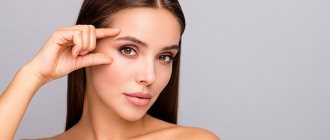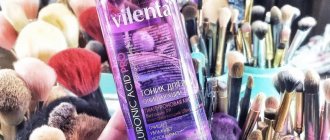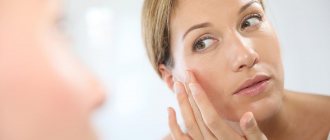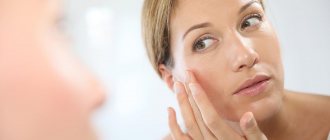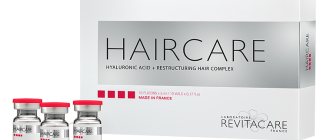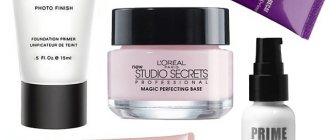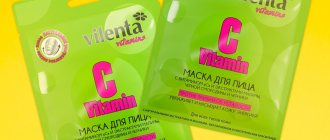There are several ingredients in cosmetology that raise questions and concerns among buyers. One of them is glycerin.
Glycerin is a colorless, viscous, non-toxic substance that is highly soluble in water. It was discovered more than 200 years ago and is now used in a wide variety of fields: in the food and medical industries, as well as in the production of cosmetics.
Glycerin has the ability to attract and retain water . It helps create a protective barrier that prevents dust and microorganisms from penetrating the upper layers of the skin. It has softening properties and does not cause allergies. Glycerol is also produced by the body's cells themselves and is involved in the circulation of water in cell membranes.
Glycerin - what is it?
Glycerol
is a moisture-retaining substance from the class of trihydric alcohols, which is widely used in the cosmetics industry and is part of moisturizing, softening and anti-aging products. The chemical formula of glycerin consists of three water molecules, which explains its hygroscopic ability to absorb water molecules from the air, accumulate them in cells and prevent transepidermal moisture loss.
Glycerin in its pure form is a syrupy, clear liquid with a sweetish taste. The component gained its popularity in cosmetology due to its low cost and high efficiency. Glycerin for the face can be found in the basis of the formulas of various cosmetic products: emulsions, creams, gels, masks, soaps and is suitable for caring for problematic and sensitive skin types.
There are several ways to make glycerin: plant, animal and synthetic production. Let's take a closer look at its forms.
Natural (natural) glycerin
In nature, the substance is found in oils and fats: animal glycerin is made from pork fat, vegetable glycerin is a derivative of palm oil, coconut oil is the most accessible and safe. The plant-based production method is the most common and is considered more environmentally friendly. It is natural vegetable glycerin that is used in cosmetology and pharmacology and is characterized by high quality and safety.
Synthetic glycerin
The industrial production method is the synthesis of glycerin from propylene. There are two synthesis technologies: the chlorine method (by chlorination of propylene) and the chlorine-free method (oxidative method through acrolein). The synthetic form of glycerin has a low degree of purity and is most often used for technical purposes.
Description and classification
Glycerin is a chemical substance (trihydric alcohol) obtained by processing fats. It is divided into 2 types: plant and animal origin. The latter is used when creating cosmetics.
There are two more varieties:
- synthetic;
- natural.
Many cosmetologists recommend using natural ones, although recent research by scientists has proven that these types are no different from each other, and in some cases it is quite difficult to accurately determine the identity of the substance.
In any case, the formation of a substance occurs as a result of a chemical process. This division is conditional, and the properties of both types are the same.
Use of glycerin for skin
In cosmetics
In skin care products, glycerin not only plays the role of a skin moisturizer, but also effectively fights the signs of early aging: smooths out wrinkles, increases skin elasticity and firmness. Cosmetics with glycerin are a good way to provide a lifting effect to the skin at home.
Due to its beneficial properties, this ingredient is often found in the basis of cosmetic formulas of natural and pharmacy products in combination with vitamins, hyaluronic acid, peptides, and vegetable oils. Glycerin is a common component in the basis of emollient and nourishing body products, some sunscreens, and shower gels. The basis of cosmetic formulas is Glycerin.
In cosmetology
In cosmetology, natural glycerin is most often found in the base of skin masks, caring and intensely moisturizing creams, and softening lotions. Such products are used at different stages of comprehensive care for dry, oily and mature skin. Check with your cosmetologist which mask recipes contain glycerin.
In pharmaceuticals
The well-known solution of pure glycerin is used in medicine as an antiseptic, emollient, moisturizer, and healing agent. Most often it is used to accelerate the healing of wounds and prevent their infection and suppuration.
Homemade cosmetics
Among homemade cosmetics, homemade soap with this moisturizing component is very popular. The advantages of home remedies are confidence in their composition and the ability to add any useful ingredient, for example, cosmetic clay, milk, vitamin E, herbal infusions, and so on.
Making homemade glycerin soap is very simple. It requires glycerol in bars, ethyl alcohol in a spray bottle, aromatic oil and a plastic form:
- melt the bar in a water bath and add a few drops of aromatic oil;
- Apply alcohol from a spray bottle to the surface of the mold;
- pour liquid glycerin into the mold;
- Spray with alcohol again;
- let harden and remove from mold.
On this simple basis, you can create a variety of options, experimenting with color and composition. Glycerin homemade soap is great for daily use. Its advantages:
- Suitable for sensitive skin.
- Improves the condition of the epidermis and is approved for use in psoriasis and eczema.
Homemade glycerin soap
To rejuvenate the skin, you can prepare a mask of glycerin and honey:
- mix liquid propanetriol and honey in equal parts;
- apply to clean skin before bed;
- Wash your face with warm water in the morning.
Are cosmetics without glycerin safe?
When choosing glycerin-free preparations, you need to take into account that instead of this component, mineral oils can be used as a necessary moisturizer and solvent. In many cases, they have an even worse effect on the skin.
Benefits of glycerin for facial skin
- Moisturizes
Glycerin creates a film on the surface of the epidermis, strengthening and restoring the hydrolipid layer. Moisturizes by literally attracting water molecules from the air and helping to retain it in the dermal layers of the skin, preventing tissue dehydration. It is important to remember that hygroscopic glycerin applied to the skin in its pure form can also dry out and cause a feeling of tightness of the epidermis, provided that the ambient humidity level is below 45%. Accordingly, the higher the air humidity, the better the substance works. - Softens
Another important property of glycerin for skin is softening. The component has a pronounced dermatoprotective effect, improves the mechanical properties of the epidermis, softens the skin and minimizes peeling, penetrating into the deep layers of the epidermis. - Renews
Glycerin also accelerates cell regeneration, promotes rapid healing of skin damage, relieves inflammation and irritation. - Protects
By strengthening the hydrolipid mantle, glycerin also strengthens the barrier properties of the skin and increases its resistance to negative environmental influences. The antiseptic properties of the substance help cells resist pathogenic bacteria and microbes. - Smoothes wrinkles
Thanks to its powerful moisturizing properties, glycerin nourishes the epidermis with moisture, filling and smoothing out dehydration creases and expression wrinkles.
Indications for the use of cosmetics with glycerin
Let's look at in what situations and for what skin imperfections it is appropriate to use glycerin in cosmetics.
- Dry skin: due to a genetic characteristic or caused by improper care.
- Dehydration and flaking, for example, due to improper care of oily and problematic skin using alcohol-containing, acidic products or aggressive alkalis.
- Loss of radiance and dull complexion.
- Photoaging caused by decreased moisture and skin damage due to prolonged exposure to sunlight.
- Expression wrinkles, dehydration creases.
- Small cracks, irritation, inflammatory foci, for example, against the background of recurrent acne.
How to rinse off correctly
Each recipe, which includes glycerin for the face, stipulates the conditions for applying the composition and the method for removing the mask. Following simple rules will help increase the effectiveness of the procedure. If the conditions are not specified in the recipe, there are general recommendations on how to properly wash off cosmetics. Experts advise:
- leave the composition on your face for at least half an hour, then remove;
- when using protein, warm water is required;
- There is no need to wash off the composition with oil, just wipe your face with a damp cloth in the morning;
- other recipes call for using cool water.
Features of using cosmetics with glycerin for different skin types
How does glycerin affect the condition of the skin in the presence of possible imperfections? Let’s look at what effect the component in cosmetics has on different skin types and the specifics of its use.
- For oily and problematic skin
It is found in moisturizing non-comedogenic gels or lotions that protect the skin from dehydration. It is also used as a basis for therapy against the background of temporary dry skin caused by aggressive components (alcohol, alkalis, acids) that are not suitable for oily skin types. - For the
dry type, the main client of glycerin for the face: the epidermis is permanently saturated with moisture, flaking is reduced, the feeling of tightness disappears, the protective properties and hydrolipid barrier are strengthened. Glycerin acts as a powerful humectant and restores softness and comfort to dry skin. - For normal and sensitive skin
Prevents dryness, dehydration, flaking. Thanks to its antiseptic and soothing properties, it relieves discomfort and irritation of the sensitive epidermis. Promotes accelerated regeneration of skin damage. Use with caution for reactive hypersensitive skin. - For combination:
Moisturizes the dry U-zone and protects against dehydration and its consequences of increased sebum production and skin thickening in the oily T-zone. - For mature skin
Increases hydration, elasticity, firmness of the skin, smoothes out visible creases of dehydration and wrinkles, has a lifting effect, strengthens, protects the epidermis.
Vegetable glycerin: where to use it
The material is used in the food industry, in the manufacture of electronic cigarettes, detergents and cosmetics, in tobacco production, medicine, agriculture, paper, textile and leather industries.
The product is used in the production of paints and varnishes, plastics, and as a flux for soldering in radio engineering and electrical engineering. It belongs to the group of stabilizers that maintain and increase the viscosity of food products. Registered as additive E422, used as an emulsifier to mix immiscible components.
The reagent burns odorless and can be easily gelled, which is why it is used for the production of transparent, high-quality candles and the base for liquids used in smoke machines. In cryonics and cryobiology, it is used as a component of popular penetrating cryoprotectors for the cryopreservation of biological tissues, anatomical preparations and organisms.
Which cosmetic products usually contain glycerin?
Most often, glycerin is found in the base of creams, masks (for skin and hair), fluids, lotions, gels, cleansers, some shampoos and hair conditioners. Many people mistakenly believe that glycerin is not used in serums, but this is not true. An example is Hyalu B5 Concentrated Anti-Wrinkle Serum from La Roche-Posay. Thus, natural (pure) glycerin in a concentration of up to 15% can be present in the base of any moisturizing, softening and anti-aging cosmetic products.
How to use glycerin on the face: top 4 ways
Apply glycerin directly to face
Step 1: Rinse your face with cool water and pat dry with a microfiber towel. Make sure your face is a little damp. Step 2: Apply some glycerin to a cotton ball. Apply lightly to skin. Step 3: Do not apply near mouth or eyes. Step 4: Leave it on for 20-30 minutes and wash off.
Glycerin as a cleanser
Use this glycerin cleanser recipe to cleanse your face.
Step 1: Mix three teaspoons of milk with a teaspoon of glycerin. Step 2: Apply the mixture to your face at night and massage gently. Rinse off in the morning.
As a dirt, oil and makeup remover
Step 1: Mix half a glass of water with one and a half tablespoons of glycerin and corn flour. Step 2: Bring the mixture to a boil until it runs clear. Step 3: Rinse your face with cool water. Step 4: Once the mixture has cooled, apply a little onto damp skin and leave on for 10-15 minutes. Rinse with cold water.
Like a homemade toner
Step 1: Wash your face. Step 2: Dilute a little glycerin with water and apply it to a damp face. This will help you tighten your pores. Step 3: Next, mix a quarter cup of glycerin with half a cup of rose water. Use this mixture as an effective tonic. Here's how you can use glycerin in a variety of ways to improve the overall health of your skin. But does glycerin cause any side effects?
Review of cosmetics with glycerin La Roche-Posay
Effaclar Micro-Exfoliating Cleansing Gel for Face and Body
EFFACLAR GEL
Micro-exfoliating gel
Thanks to an active formula that combines two types of acids and components that restore skin balance, the gel gently but intensively cleanses and exfoliates the epidermis and does not contain scrubbing particles that can injure problematic skin.
RUB 1,290 buy
A product without abrasive particles, with zinc, salicylic acid and glycerin, fights imperfections and helps smooth out signs of post-acne: stagnant spots, scars. Intensively cleanses pores, mattifies and softens the skin.
Consumer reviews:
Alexandra: I was pleasantly surprised by the effect, after washing my face was fresh, smooth, as if it was exfoliating the skin without damaging it. I use it once a day at night, so far I like it!
Christina: A godsend for those with problem skin. A pleasant menthol smell and a cooling sensation on the skin, high-quality cleansing, which, combined with good hydration, will not cause dryness. The gel is delicate, there are no scrubbing particles, exfoliation due to acids. It’s difficult to judge the effect on post-acne, since I use external therapy in combination, but for basic daily care it’s excellent.
Lily: I use it on the face. A very delicate effect and at the same time effective. From the first wash, the pores narrowed, the skin was smooth, no redness or tightness. It suited me (my skin is oily, flaky, my pores are wide). I ordered a large quantity at once and did not regret it.
Moisturizing mattifying emulsion Effaclar Mat
EFFACLAR MAT
Mattifying sebum-regulating emulsion
Contains the Sebulyse component, which reduces sebum production, providing a mattifying effect and helping to tighten pores. Intensely moisturizes and prevents skin from dehydration.
RUB 1,714 buy
An emulsion with perlite and sebulise reduces oily shine, tightens pores, instantly mattifies the skin, prevents dehydration, does not dry out, but moisturizes the skin.
Consumer reviews:
Alexandra: I’ve been using it for over a month now. The product is very light, does not dry out the skin, moisturizes, mattifies for 4 hours, softens the pore pattern in the T-zone somewhat, does not clog pores, and is a good base for makeup. The aroma is very weak, subtle and quite pleasant.
Annet: It fits well, absorbs well, no stickiness or discomfort, it really evens out the tone, a great product, I advise anyone who uses this line of products to buy it, as the makeup base has proven to be excellent.
Toleriane Sensitive Rich Moisturizing Cream
TOLERIANE SENSITIVE
Moisturizing cream for sensitive skin
Moisturizes, soothes, enhances the natural protective function of the skin.
RUB 1,111 buy
Cream for dry sensitive skin with a nourishing formula with prebiotics, niacinamide, shea butter normalizes the skin microbiome, moisturizes, soothes, softens, strengthens, and protects the skin.
Consumer reviews:
Alena: I’m very pleased with the cream. If you use it at night, then in the morning the skin will feel like after a mask, it will perfectly nourish and moisturize. In my opinion, it is ideal for the cold season, and also creates a certain barrier. It has a dense texture, easy to apply, I recommend it for dry and sensitive skin. No smell! What is very important for me, I will continue to order it, it is quite economical, lasts for a couple of months.
Sharafutdinova: The cream is good. The problem I had was that my skin was dry and the creams were not absorbed, I tried different creams. After consulting with a doctor, I bought this cream, I use it, I am very pleased. Absorbs, moisturizes, does not leave a film.
Effaclar Purifying Mattifying Mask
EFFACLAR
Purifying mattifying mask
Absorbs excess sebum, deeply cleanses, helps tighten pores and thereby has a mattifying effect, and also controls sebum production.
RUB 1,167 buy
A mask with kaolin and panthenol cleanses pores well of all types of impurities, controls sebum synthesis, mattifies the skin, does not dry out, and does not cause a feeling of tightness or discomfort. Calms inflammation, relieves redness, promotes tissue regeneration.z>
Consumer reviews:
Olga: I really liked the mask. Copes with all the tasks set in the description of this product. very economical to use. I recommend!
Valeria: An excellent mask for deep cleansing problem skin. Cleanses very well and does not dry out the skin. Pleasant texture, very economical, excellent price, I will buy more!
Lily: Very pleasant, homogeneous consistency, the pores immediately seem to be smoothed out, becoming less noticeable and deep. Treatment has become an interesting procedure, every time I get an immediate effect.
Summarize
- Vegetable glycerin is a clear, odorless and tasteless liquid obtained from vegetable fats.
- It is added to foods, cosmetics and pharmaceuticals and can provide health benefits such as hydrated and firm skin, relief from constipation, improved hydration and improved physical performance.
- If you want to try vegetable glycerin, start with a small amount to see how your body reacts.
Tags: Glycerin
- Related Posts
- Choline: what it is, properties, where it is found
- Whey protein isolate or concentrate: which is better?
- Fiber: what is it and what is it for?
« Previous entry
FAQ:
Dermatologist Alexander Prokofiev, an expert of the La Roche-Posay brand, answers the questions.
Is glycerin harmful to facial skin?
Modern cosmetics use natural glycerin of plant origin, which is absolutely safe for the skin of the face and body. To further protect yourself from allergic reactions, choose proven products, for example, buy care products in pharmacies.
Does glycerin moisturize or dry out the skin?
As part of cosmetic formulas, in a concentration of up to 15% in pure form, glycerin moisturizes, creates a hydrolipid film on the surface, prevents the evaporation of moisture from cells and prevents dehydration of the epidermis. It is not recommended to use medicated glycerin solution in its pure form for cosmetic purposes.
Can glycerin be used on the skin around the eyes?
The neck and décolleté area, like the area around the eyes, is characterized by increased dryness due to the peculiarities of its physiological structure, so these areas most need care aimed at intensively moisturizing the skin. Glycerin is often found in eyelid care products.
Is there any harm from glycerin cosmetics?
Like any chemical, glycerin can be harmful to the skin. But only if you use it in its pure concentrated form. In this form it can only be found in pharmacies. The best option would be cosmetics where glycerin in the composition is approximately in the middle of the list of ingredients, which means it has a low concentration.
How to avoid adverse consequences
In terms of moisturizing properties, cosmetologists place glycerin in second place after hyaluronic acid. But subject to following several rules for using cosmetics containing it:
- Cream with glycerin should not be used more than once a day.
- You should not apply products with it just before leaving the house. After it, the not very aesthetic shine and stickiness of the skin remains for some time.
- It is not advisable to use such creams in severe frosts and dry hot weather.
- Do not apply glycerin to areas of inflamed skin.
And we must also take into account that with continuous use, glycerin can lighten the skin by 1-2 tones. When used correctly for cosmetic purposes, glycerin has virtually no contraindications, except for individual intolerance.
Glycerin is the third most frequently used substance in cosmetics after water and aromatic additives.
If you decide to use glycerin as a monocomponent cosmetic product, be sure to dilute it with water in a 1:2 ratio.
Creams, lotions, serums and other cosmetics can be used constantly, giving the skin short breaks. In this case, there is no need to fear long-term health consequences.
